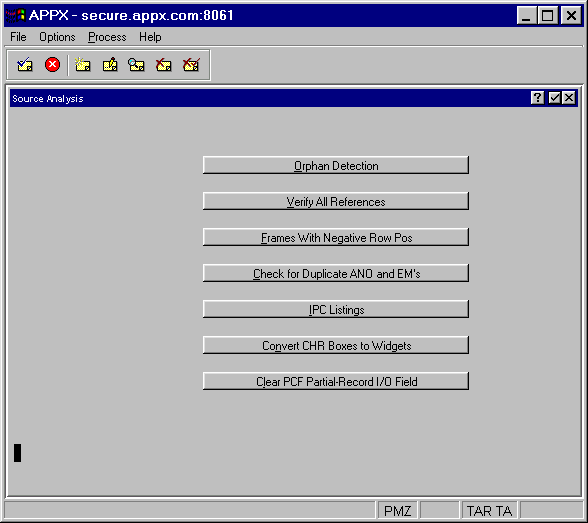


Source Analysis Menu
The Source Analysis Menu option on the Toolbox menu calls the Source Analysis menu shown in Figure 1-8-12 below:

Figure 1-8-12. Source Analysis Menu
The Source Analysis Menu contains these options:
·
Orphan Detection to generate a series
of reports that assess design elements in the application. An error is generated if any higher level
design elements in the ancestry are missing. These errors refer to “orphans”. For example, an Image
for Process “XXX” and RECORD Frame “100” would be an orphan if either the Process or the Frame were not
currently on file.
Note that these reports may not list all orphans. For instance, if there was a second Image for the
same Process and Frame in the prior example, they would both be orphans. However, only the first Image
would be listed because it sufficiently identifies any missing elements in the ancestry to remedy the
orphan status of both Images.
If you add a missing design element, the orphans become visible again. You then decide if you want
to delete any design elements from the application.
· Verify All References runs a special version of “Cross Reference All” for the current application. You can select the referenced but not defined option to generate a list of all design elements and processes that are referenced by other elements or processes yet do not exist. Or, you can select the defined but not referenced option to list all design elements and processes that exist but are not referenced anywhere in the application.
· Frames With Negative Row POs lists all frames within the application where the Row Position” field is negative or where the frame contains more rows that the screen can display at one time.
·
Check for Duplicate ANO and EMs generates
a report of any process that have a duplicate date added. These result in duplicate Executable
Modules and may cause problems. The report
also shows duplicate “area numbers” or ANO’s. These are internal pointers used to locate variables in
memory.
If a duplicate EM is reported:
1. Delete all EMs for the application
2. Run the reset
process date add fields option on the
Toolbox’s Conversion
menu.
If a duplicate ANO is reported:
1. Delete all EMs for the application
2. Initialize the BITMAP, ELEMENT, FILE, and INTIAL design files for the application
3. Process the data dictionary for the application
4. Restructure the application’s end user
data files
·
IPC Listings generates a list of IPC files
for either the applications processes or files, focusing on any exceptions from standard values. Any
exceptions found can be corrected by this utility.
IPC (Interprocess Communication) fields are used to define and control the sharing characteristics
of APPX design elements. APPX designers don’t have direct access to these fields as they are automatically
maintained by APPX based on design entry in fields such as File
Type and Share
Class.
·
Convert CHR Boxes to Widgets. Boxes were
originally implemented as CHR records in APPX Version 4.0. With Version 4.1, they have been re-implemented
as records in the WIDGET file. CHR boxes are now obsolete.
This jobs allows process selection by a query. For each process selected, any box CHR records found
are converted to WIDGET records. A log of the changed processes is produced. The conversion of a box
to a widget may fail if a widget is already defined in the same location on the image.
APPX Application
Design Manual (01/13/03)



© 2003 by APPX Software, Inc. All rights reserved